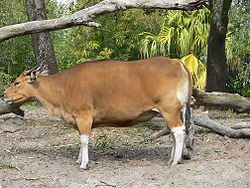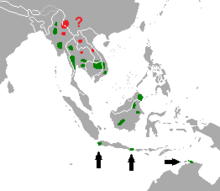Banteng
| Banteng | ||||||||||||
|---|---|---|---|---|---|---|---|---|---|---|---|---|

Male Java Banteng ( Bos javanicus javanicus ) |
||||||||||||
| Systematics | ||||||||||||
|
||||||||||||
| Scientific name | ||||||||||||
| Bos javanicus | ||||||||||||
| d'Alton , 1823 |
The Banteng ( Bos javanicus ), also known as the Sunda ox , is a wild cattle native to Southeast Asia . It has been domesticated by humans in the form of the Balirind . The wild Banteng is threatened today. The largest pure-bred wild populations live in Java in the Ujung Kulon National Park and in Thailand in the Huai Kha Khaeng Conservation Area .
features
Bantengs look vaguely similar to domestic cattle . Depending on the subspecies, the bull (male) has a black to yellow-brown fur, the cow (female) a red-brown to yellow-brown fur. Both sexes have white undersides, buttocks and legs. The animals weigh 400 to 900 kilograms, have a head-trunk length of 1.8 to 2.25 m and a shoulder height of 120 to 190 cm. The bulls have strong, curved horns that can be 70 cm long; the horns of the cows are significantly shorter at around 30 cm.
distribution
The original distribution area included the mainland of Southeast Asia and the islands of Java and Borneo . Domesticated Bantengs were brought by humans to numerous other islands in Indonesia and, in far fewer numbers, to other regions of the world (see domestication ).
Subspecies

- Java-Banteng ( B. j. Javanicus ): Java . The bulls are black, their horns have a radius of 60–70 cm. The cows are yellow-brown in color.
- Borneo-Banteng ( B. j. Lowi ): Borneo . Smaller than Java Banteng. The bulls are chocolate brown and their horns are steeper.
- Burma Banteng ( B. j. Birmanicus ): Burma , Thailand , Cambodia , Vietnam . Both cows and bulls are usually yellow-brown, but in Cambodia 20% of the bulls are blackish and on the Malay Peninsula in Thailand most of the bulls were jet black. This subspecies is classified as critically endangered by the IUCN .
Way of life
Bantengs live in groups of 2 to 40 cows with their calves and a bull. There are also herds of male bachelors and solitary bulls who are too old or too weak to lead a herd. The cows each have a young animal that is suckled for nine months and sexually mature after two years. The lifespan of a Banteng is twenty, at most over 25 years. The habitat of wild Bantengs are tropical rainforests and light forests, which are interspersed with open areas. Overall, they prefer more open and drier habitats than their relatives, the Gaure . They often come to open pastures and clearings, especially to eat. In areas where they are exposed to frequent disturbances by humans, the animals are predominantly nocturnal and hide during the day in the undergrowth of the forests to ruminate. However, they are not as shy as Gaure and often invade tilled fields.
Danger
The wild Banteng is classified as "critically endangered" by the IUCN . The destruction of the rainforests, the crossbreeding of domestic and Bali cattle as well as the infection with livestock diseases by domestic cattle are seen as reasons for its decline in the population. In mainland Southeast Asia, the numbers have declined dramatically over the past few decades. In Thailand , a decrease of 85% is believed between 1980 and 2000. The Banteng has almost disappeared from China, Cambodia, Vietnam and Laos. Bantengs died out on the Malay Peninsula as early as the 1950s. In contrast, the numbers from Java go back less, while from Myanmar no reliable numbers are available. The total population of wild banteng is estimated at 5,000 to 8,000 animals. There is no population that counts significantly more than 500 animals and only a few with over 50 animals. These are located on Java and in Thailand. In the north-east of Borneo, in the coastal area of Sabah , there may also be a few hundred animals. However, the stocks on Borneo are likely to be contaminated by the cross-breeding of Bali-domestic cattle mongrels.
The most important stocks of the wild Banteng live on Java today, especially in the Ujung Kulon National Park , where about 300–800 animals live (as of 2003), and in the Baluran National Park , where about 200 animals live (as of 2002). The only population outside of Java that surely counts more than 50 animals lives in the Huai Kha Khaeng game reserve in Thailand, where there has even been an increase in the population in recent years. Other important occurrences can be found in the Kaeng Krachan National Park in Thailand, which may also have over 50 animals, and in the Kulamba Game Reserve in northeast Borneo, which is roughly estimated to be home to at least 100 animals.
The largest population of wild Bantengs is today outside of the original range in Northern Australia. The population occurs in the far north of the continent, in the area of the Garig Gunak Barlu National Park , and is estimated at over 8000 animals. This population is real wild bantengs, not feral Bali cattle.
Domestication

Bantengs are one of the five species of cattle that have been domesticated by humans. The domesticated form of the Banteng is known as the Balirind. The time of domestication is unknown, but must have been several centuries before the birth of Christ. Java is believed to be the most likely place where humans first tamed Bantengs ; on the mainland there was no need for another domesticated cattle species because of the preferred water buffalo . Since Bali was the center of Banteng breeding for centuries, domesticated Bantengs are known under the name Balirind.
The typical Balirind differs from the wild Banteng because of its smaller body size and the longer neck dewlap. The cops are never completely black either. The domesticated Bantengs on Java differ much less from the wild form and can hardly be distinguished from it externally. Today there are around 1.5 million Bali cattle.
From Bali, the domesticated animals made their way to numerous islands on which wild Bantengs were not originally native, for example to Sumatra , Sulawesi , Timor , Lombok and Sumbawa . Some of the animals went wild on these islands. The feral Bantengs in Australia, which were previously kept for Bali cattle, are pure-bred Bantengs according to recent genetic analyzes. They were introduced in Australia in 1849 , where they now represent a population of 8,000-10,000 animals, which is native to the Garig Gunak Barlu National Park in the Northern Territory .
With the introduction of domestic cattle into Indonesia, there are fewer and fewer pure Bali cattle. Crossbreeds between zebus and Bali cattle took place early on , creating new breeds of cattle.
See also
literature
- Ronald M. Nowak: Walker's Mammals of the World . Johns Hopkins University Press, 1999 ISBN 0-8018-5789-9
- Helmut Lingen: Large lexicon of animals . Lingen Verlag, 1989
Web links
- Species description at ultimateungulate.com
- Video: Bibos banteng - gallop . Institute for Scientific Film (IWF) 1954, made available by the Technical Information Library (TIB), doi : 10.3203 / IWF / E-10 .
Individual evidence
- ↑ a b Bos javanicus in the IUCN Red List of Threatened Species 2012.1. Posted by: Timmins, RJ, Duckworth, JW, Hedges, S., Steinmetz, R. & Pattanavibool, A., 2008. Retrieved October 5, 2012.
- ↑ a b Corey JA BRADSHAW Brandshaw, Barry BARRY W. Brook (2007): Ecological-economic models of sustainable harvest for an endangered but exotic megaherbivore in northern Australia Natural Resource Modeling, Volume 20, Issue 1, pages 129-156



